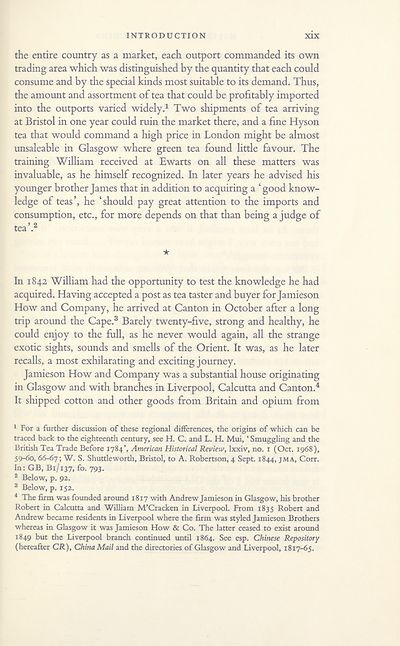Series 4 > William Melrose in China, 1845-1855
(24) Page xix
Download files
Complete book:
Individual page:
Thumbnail gallery: Grid view | List view

INTRODUCTION
xix
the entire country as a market, each outport commanded its own
trading area which was distinguished by the quantity that each could
consume and by the special kinds most suitable to its demand. Thus,
the amount and assortment of tea that could be profitably imported
into the outports varied widely.1 Two shipments of tea arriving
at Bristol in one year could ruin the market there, and a fine Hyson
tea that would command a high price in London might be almost
unsaleable in Glasgow where green tea found little favour. The
training William received at Ewarts on all these matters was
invaluable, as he himself recognized. In later years he advised his
younger brother James that in addition to acquiring a ‘good know¬
ledge of teas’, he ‘should pay great attention to the imports and
consumption, etc., for more depends on that than being a judge of
tea’.2
In 1842 William had the opportunity to test the knowledge he had
acquired. Having accepted a post as tea taster and buyer for Jamieson
How and Company, he arrived at Canton in October after a long
trip around the Cape.3 Barely twenty-five, strong and healthy, he
could enjoy to the full, as he never would again, all the strange
exotic sights, sounds and smells of the Orient. It was, as he later
recalls, a most exhilarating and exciting journey.
Jamieson How and Company was a substantial house originating
in Glasgow and with branches in Liverpool, Calcutta and Canton.4
It shipped cotton and other goods from Britain and opium from
1 For a further discussion of these regional differences, the origins of which can be
traced back to the eighteenth century, see H. C. and L. H. Mui, ‘ Smuggling and the
British Tea Trade Before 1784’, American Historical Review, Ixxiv, no. x (Oct. 1968),
59-60,66-67; W. S. Shuttleworth, Bristol, to A. Robertson, 4 Sept. 1844, jma, Corr.
In: GB, Bi/137, fo. 793.
8 Below, p. 92.
3 Below, p. 152.
4 The firm was founded around 1817 with Andrew Jamieson in Glasgow, his brother
Robert in Calcutta and William M’Cracken in Liverpool. From 1835 Robert and
Andrew became residents in Liverpool where the firm was styled Jamieson Brothers
whereas in Glasgow it was Jamieson How & Co. The latter ceased to exist around
1849 but the Liverpool branch continued until 1864. See esp. Chinese Repository
(hereafter CR), China Mail and the directories of Glasgow and Liverpool, 1817-65.
xix
the entire country as a market, each outport commanded its own
trading area which was distinguished by the quantity that each could
consume and by the special kinds most suitable to its demand. Thus,
the amount and assortment of tea that could be profitably imported
into the outports varied widely.1 Two shipments of tea arriving
at Bristol in one year could ruin the market there, and a fine Hyson
tea that would command a high price in London might be almost
unsaleable in Glasgow where green tea found little favour. The
training William received at Ewarts on all these matters was
invaluable, as he himself recognized. In later years he advised his
younger brother James that in addition to acquiring a ‘good know¬
ledge of teas’, he ‘should pay great attention to the imports and
consumption, etc., for more depends on that than being a judge of
tea’.2
In 1842 William had the opportunity to test the knowledge he had
acquired. Having accepted a post as tea taster and buyer for Jamieson
How and Company, he arrived at Canton in October after a long
trip around the Cape.3 Barely twenty-five, strong and healthy, he
could enjoy to the full, as he never would again, all the strange
exotic sights, sounds and smells of the Orient. It was, as he later
recalls, a most exhilarating and exciting journey.
Jamieson How and Company was a substantial house originating
in Glasgow and with branches in Liverpool, Calcutta and Canton.4
It shipped cotton and other goods from Britain and opium from
1 For a further discussion of these regional differences, the origins of which can be
traced back to the eighteenth century, see H. C. and L. H. Mui, ‘ Smuggling and the
British Tea Trade Before 1784’, American Historical Review, Ixxiv, no. x (Oct. 1968),
59-60,66-67; W. S. Shuttleworth, Bristol, to A. Robertson, 4 Sept. 1844, jma, Corr.
In: GB, Bi/137, fo. 793.
8 Below, p. 92.
3 Below, p. 152.
4 The firm was founded around 1817 with Andrew Jamieson in Glasgow, his brother
Robert in Calcutta and William M’Cracken in Liverpool. From 1835 Robert and
Andrew became residents in Liverpool where the firm was styled Jamieson Brothers
whereas in Glasgow it was Jamieson How & Co. The latter ceased to exist around
1849 but the Liverpool branch continued until 1864. See esp. Chinese Repository
(hereafter CR), China Mail and the directories of Glasgow and Liverpool, 1817-65.
Set display mode to:
![]() Universal Viewer |
Universal Viewer | ![]() Mirador |
Large image | Transcription
Mirador |
Large image | Transcription
Images and transcriptions on this page, including medium image downloads, may be used under the Creative Commons Attribution 4.0 International Licence unless otherwise stated. ![]()
| Scottish History Society volumes > Series 4 > William Melrose in China, 1845-1855 > (24) Page xix |
|---|
| Permanent URL | https://digital.nls.uk/127694865 |
|---|
| Description | Over 180 volumes, published by the Scottish History Society, containing original sources on Scotland's history and people. With a wide range of subjects, the books collectively cover all periods from the 12th to 20th centuries, and reflect changing trends in Scottish history. Sources are accompanied by scholarly interpretation, references and bibliographies. Volumes are usually published annually, and more digitised volumes will be added as they become available. |
|---|


